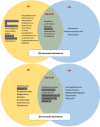Evidence Suggesting the Role of Gut Dysbiosis in Diabetic Retinopathy
- PMID: 35877085
- PMCID: PMC9339698
- DOI: 10.1167/iovs.63.8.21
Evidence Suggesting the Role of Gut Dysbiosis in Diabetic Retinopathy
Abstract
Purpose: Gut dysbiosis has been identified and tested in human trials for its role in diabetes mellitus (DM). The gut-retina axis could be a potential target for retardation of diabetic retinopathy (DR), a known complication of DM. This study reviews the evidence suggesting gut dysbiosis in DR.
Methods: The published literature in the past 5 years was reviewed using predetermined keywords and articles. The review intended to determine changes in gut microbiome in DR, the hypothesized mechanisms linking to the gut-retina axis, its predictive potential for progression of DR, and the possible therapeutic targets.
Results: The gut microbiota of people with DM differ from those without it, and the gut microbiota of people with DR differ from those without it. The difference is more significant in the former (DM versus no DM) and less significant in the latter (DM without DR versus DM with DR). Early research has suggested mechanisms of the gut-retina axis, but these are not different from known changes in the gut microbiome of people with DM. The current evidence on the predictive value of the gut microbiome in the occurrence and progression of DR is low. Therapeutic avenues targeting the gut-retina axis include lifestyle changes, pharmacologic inhibitors, probiotics, and fecal microbiota transplantation.
Conclusions: Investigating the therapeutic utility of the gut ecosystem for DM and its complications like DR is an emerging area of research. The gut-retina axis could be a target for retardation of DR but needs longitudinal regional studies adjusting for dietary habits.
Conflict of interest statement
Disclosure:
Figures


References
-
- International Diabetes Federation. IDF Diabetes Atlas, 10th edn. Brussels, Belgium: International Diabetes Federation, 2021, https://www.bionity.com/en/associations/61015/international-diabetes-fed.... Accessed October 29, 2021.
-
- Tilahun M, Gobena T, Dereje D, Welde M, Yideg G.. Prevalence of diabetic retinopathy and its associated factors among diabetic patients at Debre Markos Referral Hospital, northwest Ethiopia, 2019: hospital-based cross-sectional study. Diabetes Metab Syndr Obes Targets Ther. 2020; 13: 2179–2187. - PMC - PubMed
-
- Steinmetz JD, Bourne RRA, Briant PS, et al. .. Causes of blindness and vision impairment in 2020 and trends over 30 years, and prevalence of avoidable blindness in relation to VISION 2020: the Right to Sight: an analysis for the Global Burden of Disease Study. Lancet Glob Health. 2021; 9(2): e144–e160. - PMC - PubMed
-
- Porta M, Bandello F.. Diabetic retinopathy. Diabetologia. 2002; 45(12): 1617–1634. - PubMed
Publication types
MeSH terms
Grants and funding
LinkOut - more resources
Full Text Sources
Medical
Miscellaneous

